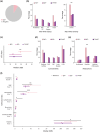Autoantibodies in hospitalised patients with COVID-19
- PMID: 39734590
- PMCID: PMC11671454
- DOI: 10.1002/cti2.70019
Autoantibodies in hospitalised patients with COVID-19
Abstract
Objectives: CD209L and its homologous protein CD209 act as alternative entry receptors for the SARS-CoV-2 virus and are highly expressed in the virally targeted tissues. We tested for the presence and clinical features of autoantibodies targeting these receptors and compared these with autoantibodies known to be associated with COVID-19.
Methods: Using banked samples (n = 118) from Johns Hopkins patients hospitalised with COVID-19, we defined autoantibodies against CD209 and CD209L by enzyme-linked immunosorbent assay (ELISA). Clinical associations of these antibodies were compared with those of patients with anti-interferon (IFN) and anti-angiotensin-converting enzyme-2 (ACE2) autoantibodies.
Results: Amongst patients hospitalised with COVID-19, 19.5% (23/118) had IgM autoantibodies against CD209L and were more likely to have coronary artery disease (44% vs 19%, P = 0.03). Antibodies against CD209 were present in 5.9% (7/118); interestingly, all 7 were male (P = 0.02). In our study, the presence of either antibody was positively associated with disease severity [OR 95% confidence interval (95% CI): 1.80 (0.69-5.03)], but the association did not reach statistical significance. In contrast, 10/118 (8.5%) had IgG autoantibodies against IFNα, and 21 (17.8%) had IgM antibodies against ACE2. These patients had significantly worse prognosis (intubation or death) and prolonged hospital stays. However, when adjusting for patient characteristics on admission, only the presence of anti-ACE2 IgM remained significant [pooled common OR (95% CI), 4.14 (1.37, 12.54)].
Conclusion: We describe IgM autoantibodies against CD209 and CD209L amongst patients hospitalised with COVID-19. These were not associated with disease severity. Conversely, patients with either anti-ACE2 IgM or anti-IFNα IgG antibodies had worse outcomes. Due to the small size of the study cohort, conclusions drawn should be considered cautiously.
Keywords: COVID‐19; anti‐ACE2 IgM; anti‐CD209 IgM; anti‐CD209L IgM; autoantibodies.
© 2024 The Author(s). Clinical & Translational Immunology published by John Wiley & Sons Australia, Ltd on behalf of Australian and New Zealand Society for Immunology, Inc.
Conflict of interest statement
The authors declare no conflicts of interest.
Figures




Similar articles
-
CD209L/L-SIGN and CD209/DC-SIGN act as receptors for SARS-CoV-2.bioRxiv [Preprint]. 2021 Jun 14:2020.06.22.165803. doi: 10.1101/2020.06.22.165803. bioRxiv. 2021. Update in: ACS Cent Sci. 2021 Jul 28;7(7):1156-1165. doi: 10.1021/acscentsci.0c01537. PMID: 32607506 Free PMC article. Updated. Preprint.
-
CD209L/L-SIGN and CD209/DC-SIGN Act as Receptors for SARS-CoV-2.ACS Cent Sci. 2021 Jul 28;7(7):1156-1165. doi: 10.1021/acscentsci.0c01537. Epub 2021 Jun 30. ACS Cent Sci. 2021. PMID: 34341769 Free PMC article.
-
Presence and Implications of Anti-Angiotensin Converting Enzyme-2 Immunoglobulin M Antibodies in Anti-Melanoma-Differentiation-Associated 5 Dermatomyositis.ACR Open Rheumatol. 2022 May;4(5):457-463. doi: 10.1002/acr2.11423. Epub 2022 Mar 1. ACR Open Rheumatol. 2022. PMID: 35229496 Free PMC article.
-
ACE2-Independent Alternative Receptors for SARS-CoV-2.Viruses. 2022 Nov 16;14(11):2535. doi: 10.3390/v14112535. Viruses. 2022. PMID: 36423144 Free PMC article. Review.
-
C-type Lectin CD209L/L-SIGN and CD209/DC-SIGN: Cell Adhesion Molecules Turned to Pathogen Recognition Receptors.Biology (Basel). 2020 Dec 22;10(1):1. doi: 10.3390/biology10010001. Biology (Basel). 2020. PMID: 33375175 Free PMC article. Review.
References
-
- WHO Coronavirus (COVID‐19) Dashboard. https://covid19.who.int (accessed 27 September 2023).
-
- United States of America . WHO Coronavirus disease (COVID‐19) dashboard with vaccination data. https://covid19.who.int (accessed 27 September 2023).
-
- Centers for Disease Control and Prevention (CDC) . COVID Data Tracker. 2020. https://covid.cdc.gov/covid‐data‐tracker (accessed 27 September 2023).
LinkOut - more resources
Full Text Sources
Miscellaneous
